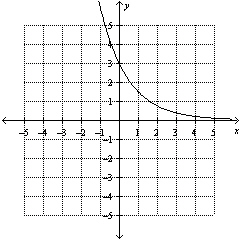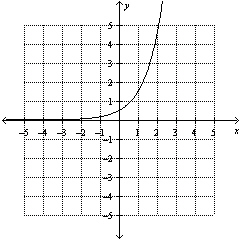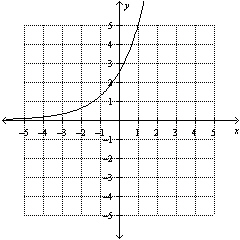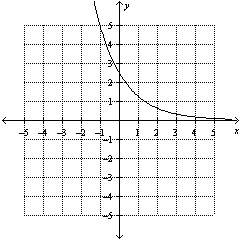Multiple Choice
Identify the choice that best
completes the statement or answers the question.
|
|
|
1.
|
How many y-intercepts does the exponential function f( x) =
 (5) x have?
|
|
|
2.
|
How many turning points does the exponential function f( x) =  ( p) x have?
|
|
|
3.
|
Which of the following is an exponential function?
A. | f(x) = x2 | B. | g(x) =
(–1)x | C. | h(x) =
17x | D. | j(x) = 23 –
x |
|
|
|
4.
|
Which of the following is an exponential function?
A. | f(x) = p(1)x | B. | g(x) =
3(–7)x | C. | h(x) = 4(p)x | D. | j(x) =
x(2)x |
|
|
|
5.
|
Match the following graph with its function.  A. | y = 3(0.5)x | B. | y =
2(1.25)x | C. | y =
0.5(3)x | D. | y =
2(0.75)x |
|
|
|
6.
|
Match the following graph with its function.  A. | y = 3(0.5)x | B. | y =
2(1.25)x | C. | y =
0.5(3)x | D. | y =
2(0.75)x |
|
|
|
7.
|
Match the following graph with its function. 
|
|
|
8.
|
Match the following graph with its function. 
|
|
|
9.
|
Determine the y-intercept of the exponential function f( x)
=  .
|
|
|
10.
|
Determine the y-intercept of the exponential function j(x)
= a(b)x, if a > 0, b > 0.
|
Short Answer
|
|
|
1.
|
Complete the table of values for the function f( x) =
2 x.
|
|
|
2.
|
Complete the table of values for the function g( x) =  .
|
|
|
3.
|
Determine if the data in the table represents an exponential function. Provide
your reasoning. x | –2 | –1 | 0 | 1 | 2 | 3 | y | 0.08 | 0.4 | 2 | 10 | 50 | 250 | | | | | | | |
|
|
|
4.
|
Determine the y-intercept of the exponential function g( x)
=  .
|
|
|
5.
|
Determine if the exponential function f( x) =  is
increasing or decreasing.
|
|
|
6.
|
Determine if the exponential function g( x) =  is
increasing or decreasing.
|
|
|
7.
|
Determine if the exponential function h( x) =  is
increasing or decreasing.
|
|
|
8.
|
Determine if the exponential function h( x) =  is
increasing or decreasing.
|
|
|
9.
|
State the domain of the exponential function h( x) =  .
|
|
|
10.
|
Sketch the exponential function f( x) =  .
|
|
|
11.
|
Sketch the exponential function h( x) =  .
|
Problem
|
|
|
1.
|
Which exponential function matches each graph below? Provide your
reasoning.
|
|
|
2.
|
Which exponential function matches each graph below? Provide your
reasoning.
|
|
|
3.
|
Which exponential function matches each graph below? Provide your
reasoning.
|
|
|
4.
|
A vehicle was purchased for $15 000 in 2005. The book value of the vehicle can
be modelled by the exponential function  where y represents the
value in dollars and x represents the time, in years, after 2005. a) How does the
value of the vehicle change over time? Explain how you know. b) Estimate the value of the
vehicle in 2015. Show your work.
|
|
|
5.
|
The number of computers infected with a new computer virus, y, can be
modelled by the exponential function  where x represents the time, in days,
after the initial infection. a) How does the number of affected computers change over time?
Explain how you know. b) Estimate the number of the affected computers after a week. Show
your work.
|
|
|
6.
|
An increasing exponential function y =
a(b)x and a decreasing exponential function y =
c(d)x intersect at the point (0, 3).
a) Which
characteristics of the functions are the same? Which characteristics would be different?
b)
Write the equations of two possible functions. Explain how you chose your functions.
|
|
|
7.
|
Use what you know about the exponential function  to predict the
number of x-intercepts, the y-intercept, the end behaviour, the domain, and the range
of the following function: 
|